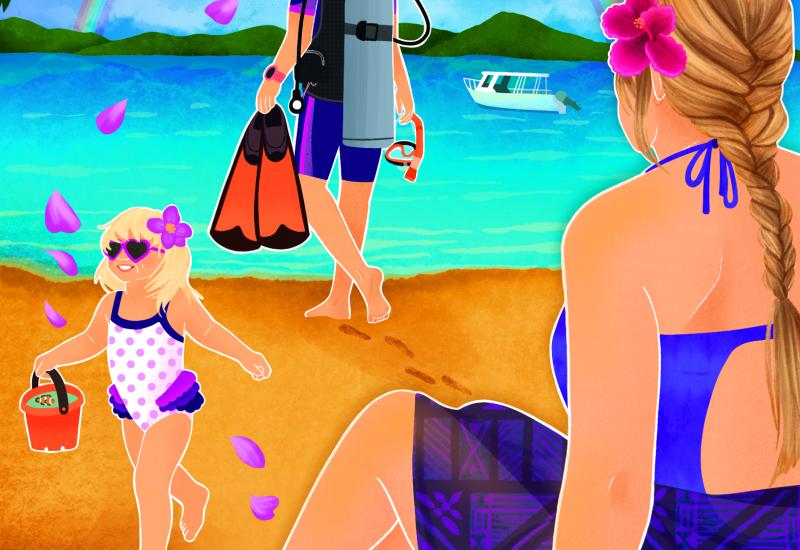A Diver’s Guide to the World: Exploring Above and Beneath the Surface

Magnus LarssonAuthors Carrie Miller and Chris Taylor diving in Ko Lanta, Thailand.
What was your favorite place visited while researching for your book?
We are always asked that question, and our answer is always the same: It depends on the moment. I might be longing to wander the ancient walled city of Saint-Malo, France, and watch the 42-foot tide gather force until it pounds at the 10-foot-thick city walls before retreating along a golden beach. Chris might be missing the marine action of the Galapagos. From a land base (not liveaboard), he saw scalloped hammerheads, whitetip reef sharks, schools of tuna and barracuda, a squadron of mobula rays, a sea lion and a mola mola—all on a single dive.
But it changes. Five minutes later, we might be wanderlusty for another location or lost in another memory.
Travel is transformative. It gets under the skin, changing hearts and minds, revisiting us like an old friend when we least expect it to. And dive travel (or ocean travel) is no different.
Related Reading: The Charismatic Animals You Can Only Dive With in the Galapagos

Carrie Miller and Chris TaylorMany divers opt for liveaboards in the Galapagos, but land-based diving (and adventures) is spectacular, and your visit benefits local communities.
A Remarkable Journey
Our book, A Diver’s Guide to the World: Remarkable Dive Travel Destinations Above and Beneath the Surface, was born from love—a love of travel and a love of the ocean, the blue expanse that covers more than 70 percent of our planet’s surface.
Although the land and sea are wonderfully and inextricably interconnected, travelers tend to visit one or the other. Scuba divers seek out underwater realms, impatiently counting down surface intervals until their next dive. Land-lovers might venture out for the occasional snorkel, but they’re glimpsing only a pixel of the bigger picture. Exploring both underwater and on land is the most holistic way of experiencing a destination—it’s seeing the complete picture, the best of both worlds.
Ours is a book for those explorations—for ocean travelers. It’s a different kind of guidebook, written for divers who like to travel, travelers with an interest in the underwater world or divers traveling with non-diving companions.

Carrie Miller and Chris TaylorThe South Pacific island of Niue is one of the world’s smallest countries situated on one of the world’s largest raised coral atolls. There aren’t many beaches, but there are plenty of rock pools, caves and chasms.
To create our book, we traveled to 50 locations in 35 countries over 14 continuous months, spending more than 250 hours underwater. At the start, we each had different experience levels. (Chris was an experienced diver; Carrie was brand new.) Learning to dive gifted me a new perspective; it made my world bigger. It also gave our book a point of difference: We’re writing for seasoned divers and new, inexperienced or out-of-practice divers. Our book contains some tried-and-true favorites like Mexico and the Bahamas, as well as some off-the-beaten-dive-track destinations, like Easter Island and Australia’s Cocos (Keeling) Islands.
We take you on adventures with dragons and manta rays in Komodo. We ride horses in the opal-tinted Indian Ocean off Zanzibar, and linger in the land and sea gardens of Bormes-les-Mimosas, home to the first marine park in Europe and a stone’s throw from the glittering Cote d'Azur. We dive in with white sharks and whale sharks in Australia, and experience surf-and-turf safariing in South Africa.
Related Reading: 6 Riveting Books That Explore the Ocean
The Importance of Seeing the Sea
There is a purpose to these extraordinary travel experiences: conservation through exploration. Jacques Cousteau was insistent that “we must go and see for ourselves." He understood people are stronger advocates for things they have seen and experienced directly.
Substation CuracaoChris and Carrie are all smiles in Substation Curacao’s minisub, which takes visitors to frontier depths of 1,000 feet/305 meters.
During our 14 months on the road, we had the privilege of seeing the world in a snapshot of time, and what we saw was staggering. People have asked us if we saw the beginnings of climate change, and our answer is: No, we saw it in full-flood. It’s happening now. Every place we visited has changed drastically in the past five years. Weather patterns are shifting, species are migrating and everywhere there is degradation and rivers of plastic.
However, in every place we visited, we also met legions of people who are fighting to make a difference, and we’ve included them in our book. Each chapter highlights a global issue, from the necessity of protecting remarkable ecosystems like coral reefs and mangroves, to sea turtle and shark conservation, to the importance of the high seas. We feature scientists and organizations that are striving to make a difference and suggest ways you can get involved—hands-on experiences; learning more; and donating your time, money or talents.
Scuba divers (of any level of ability) are natural ambassadors for the ocean, and we need as many people to see the sea as we can.
Watch This Space
Now, we’re about to embark on an exciting new adventure! This introduction marks the start of a monthly series, during which we’ll highlight 12 unique locations from our book—including some exclusive behind-the-scenes stories. We’ll include dive travel information for each destination, insider tips, the level of diving each destination is best-suited to, and ideas for how to dive in, get involved and make a difference. We hope you’ll join us on a remarkable journey around the world.

To create their one-of-a-kind National Geographic book, A Diver’s Guide to the World: Remarkable Dive Travel Destinations Above and Beneath the Surface, dive travel experts Carrie Miller and Chris Taylor traveled to 50 inspirational locations around the world, spending more than 250 hours underwater. Their monthly column explores the world using a mix of chapter excerpts and exclusive behind-the-scenes stories. Their project, Beneath the Surface Media, uses storytelling and ocean travel to encourage conservation through exploration. For more, follow them on Instagram and Facebook.










